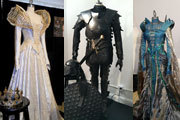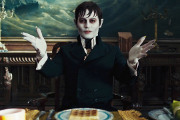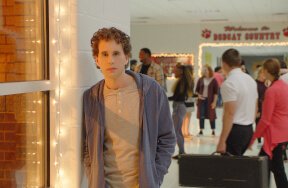By: Lynn Barker
Still like playing with dolls or action figures? Hey, no shame factor there. The adult filmmakers at Laika Films outside Portland, Oregon do it every day. Kidzworld was recently invited to tour the studio where ParaNorman is being shot.
In the film, tween Norman (voiced by Kodi Smit-McPhee), is able to speak with the dead. Good thing since his town is being overrun by zombies! Norman will also have to take on ghosts, a witch and, worst, of all, grown-ups, to save the locals from a centuries-old curse. We took a tour of the Laika studios and learned all about the whole stop motion process from concept to finished product. It’s fascinating!
 Courtney, Norman, Alvin, Neil and Mitch hit the roadCourtesy of Laika Inc
Courtney, Norman, Alvin, Neil and Mitch hit the roadCourtesy of Laika Inc
Laika also made the very cool stop motion animation film Coraline and filmmakers tell us that the process has grown by leaps and bounds since then. In case you are going “huh?”, here’s the haps. Ever draw a flip book; separate drawings that seem to move when you flip through fast? Stop motion animation is much like that except rather than flat drawings, animators use three-dimensional puppets that resemble dolls or action figures as “actors” for the film. The animator poses the puppet on a detailed set then takes a still picture. The puppet is moved another miniscule amount and another shot is taken. When it is all put together.. voila! You’ve got a movie like Coraline.
Creating Puppets: Step by Step
It took 60 puppet makers to create 178 individual puppets for ParaNorman. In the puppet workshops, which also serve as emergency hospitals when the little “actors” are damaged, we saw tons of puppets and tiny props. There are 28 Normans and between 9 and 12 puppets of lesser characters. Most are about 9 inches tall, some taller. There are puppets of ghosts, zombies, a witch, kids and adults. We even saw a cute 3 inch puppet of a ghost dog named Bob and many adorable mini-props all hand made.
 Norman with town kidsCourtesy of Laika Inc
Norman with town kidsCourtesy of Laika Inc
Heidi Smith was the artist designing the characters using paper and pencil. From those drawings, a maquette (large-ish doll) is made as a guideline. When that’s approved, the actual puppets are made. We talked to puppet costumers whose stitches on 120 costumes had to be tiny to be to scale on camera and wigmakers making wigs out of mohair and goat hair (in Norman’s case). On some puppets, even each strand of hair, on a wire, can be adjusted by the animators. One female puppet’s ponytail is moved frame by frame so it looks like it is bouncing as she walks.
Underneath the puppets’ plastic “skin” is an armature; a teeny silver “skeleton” with hundreds of movable joints (picture a mini Terminator). This frame has to be strong to withstand the many times each puppet will be “moved”. Every stop motion puppet ever in a movie, including the very first King Kong giant gorilla in 1933, had a metal armature.
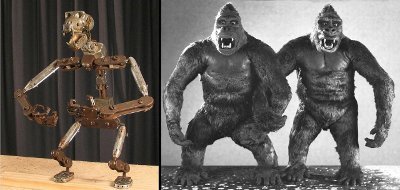 King Kong armature and puppetsPhoto Courtesy of Bob Burns
King Kong armature and puppetsPhoto Courtesy of Bob Burns
Before modern plastics, people used fine leather or later foam latex for puppet skin over wires and animated puppets that way,
Making Puppets Smile and Scream
Georgina Hayns, Laika’s Creative Supervisor for Puppet Fabrication told us that there are two kinds of facial animation for puppets. One is mechanical where an animator can move the actual face of the puppet because of the armature underneath its skin but this is limited. When filmmakers want more expressions, it’s time for modern technology to take over.
Brian McLean is Director of Rapid Prototype for the movie. Whaaaa???? Okay, here’s some of our conversation. This is how the Norman puppets get tons of different faces to put on and take off for each of his more difficult and extreme expressions.
Kidzworld: Brian, what is a Rapid Prototype Printer? It looks like a big Xerox machine.
- Brian: This is a printer that will take a 3-D computer file made and sent to it by our computer animators (who are half artists, half engineers) and it will literally make that up in 3-D so you can hold it in your hand (like a real doll or toy). Instead of printing flat on paper, it makes a 3-dimensional object. It can make things in silicon, metal and more. (They gave us a tiny working wrench and a Norman head made on the “printer” to illustrate).
Kidzworld: Wow, that’s so futureworld!
- Brian: On Coraline we used a plastic printer. We were the first company to use this process for a stop motion film. Technology moved forward. We have new printers now that can print heads and objects in color so we don’t have to paint each sculpted head by hand. We can even print loads of freckles on the face, no painting them. You can see shadows and highlights on each face. We work with the puppet department closely so everything matches; old and new style animation are married together.
The first color faces we made were great on greens and yellows but not other colors. We had to do a lot of research and development to get all the colors right. (Note: Matching colors from computers to the actual printer was hard.. just like at home if your photo colors on your computer screen don’t match what your printer prints out.)
Kidzworld: But what exactly are these little heads with different expressions made of?
-
Brian: They are colored resin over a powder material and they are cured with an ultra violet light.
Tiny ParaNorman head Courtesy of Lynn Barker
Kidzworld: Like gel fingernails!! I get it! (laughter).
- Brian: Sort of and we can get about 40 heads made at the same time. It takes about an hour and a half. For Norman we have about 14,000 facial expressions. There were 100 faces done for Norman just for a scene where he’s brushing his teeth. The puppet animators then pick which faces they need on their puppets for what scene; frowns, smiles, etc. Norman has 290,000 possible facial expressions. More range of emotion than we will ever have. Coraline had about 200,000. CG animated characters like in the Pixar films have such life and emotion in their faces. With stop-motion animation combining age-old technology with this modern technology, we can compete with CG.
All the limitations we had are gone. These Rapid Prototype Printers can be used for a lot of things like making heart valves for transplant and, in the future you can buy a pattern for a basketball and print it out at home.
Kidzworld: Wow!
In Part 2 of our set visit exclusive we talk with the movie’s two directors and visit the many animators actually moving and posing the puppets on little detailed sets to make the movie with still cameras, one shot at a time.
ParaNorman opens in theaters everywhere August 17th.

































.jpg)

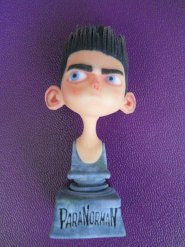 Tiny ParaNorman head
Tiny ParaNorman head 
